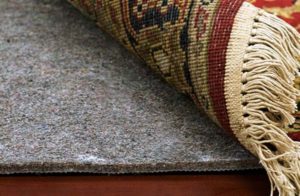
If you’re thinking of buying a new rug pad, the best way to decide is to consider a few things. Consider spills, foot traffic, and pet accidents. Also, consider the durability of the rug pad. This will determine how long you will have to clean it.
Spills
It is important to clean your rug pad regularly, as spills can build up very quickly. For most spills, blotting with plain water will do the trick. Avoid rubbing the place, as this will only cause the spill to sink deeper. Rug pads have other benefits, including reducing noise and cushioning your feet. To keep them looking great, follow these tips. You can also buy special rug pads to protect your floors from stains.

The best pads are made of natural materials. Natural materials don’t contain toxic chemicals like PVC, which is not recommended for indoor use best oriental rug pad. In addition to being unsustainable, PVC contains VOCs that harm the human body. Memory foam pad options are also available, which help absorb noise and reduce the risk of sound transferring to the floor. Some are waterproof.
The thickness of the pad is also a factor to consider. The floor will not absorb the liquid if the pad is too thin. Also, thicker pads can protect the floor from noise and heat. This is especially useful if there are children or pets in the home. A thick pad can prevent spills from making the carpet bare.
Pet accidents
Regarding cleaning up pet accidents, rug pads are an important accessory. Not only do they absorb pet urine, but they also trap the smell. Pet urine stains on area rugs are not just unsightly; they can cause permanent discoloration and foul odors. Some rug pads even feature a leak-proof barrier, preventing puddles from forming on the floor. Rubberized rug pads also help prevent rugs from shifting after being wet.
Rug pads come in various sizes, and larger rolls are available for larger rugs. Choosing the right size for your area rug is essential to avoiding damage to the floor. Make sure you check the loft and clearance measurements of the carpet before buying a pad.
Remember that accidents are common in a household with kids and pets. If you use felt pads, you may need to blot the spills with extra paper towels to avoid damaging the rug. On the other hand, water-resistant cushions can be easily cleaned by blotting with a paper towel.
First, blot the area with a dry paper towel to clean up pet accidents to remove any debris and spills. It is important not to rub the area with water, as this will cause it to bleed and spread the contamination. You can also use an over-the-counter pet stain removal product, which is widely available. Be careful not to overuse the stain because the chemistry in these products can damage the fibers and cause bleaching, dye migration, and other damage.
Foot traffic
Rug pads should be cleaned every few months, depending on the traffic they receive. However, they do not need to be cleaned as often as rugs. To clean them, shake them out or vacuum them. Memory foam or felt pads should also be swept after shaking. Cleaning them regularly will help prevent them from becoming soiled.
Rug pads should be replaced every few years because they will start to break down over time. While some can last up to 15 years, most are designed to last only a few years. Some manufacturers provide an estimated lifespan in their manual, so it is a good idea to check the manual before purchasing a new one.
Generally, you should replace the pad when its performance is no longer as good as when you first bought it. For instance, memory foam rug pads may not grip the rug as well as they did, and grip rug pads may be losing their grip.
Rug pads can help protect your area rug from damage from foot traffic. They absorb most of the impact from foot traffic and cushion the rug fibers. Without a pad, area rugs will wear out sooner. They also help with sound insulation. By investing in a good quality rug pad, you can enjoy the beauty of your rug for many years.
In general, rug pads should be between 1/8 and 1/4 inch thick. Although thicker pads can provide better cushioning, they can cause your rug to become more vulnerable to punctures. Generally, thicker pads are better for mats that rest on uneven surfaces, but thicker pads can also be seen through thin rugs.
Cost
The cost of changing rug pads varies depending on the quality and type of rug. Some pads are washable, while others can be disposed of after they’ve been used for several years. Regardless of the type, it is a good idea to change them periodically. Professional rug cleaners recommend changing pads every three to four years.
Rug pads can change the look and feel of a rug. They can add extra cushioning, spring, and even sound-dampening properties. You can test various types of pads side-by-side, allowing you to see which one works best with the kind of rug you have.
If you’re replacing a rug, you should make sure the rug pad is non-stick and stays in place. The instructions that come with the pillow should indicate which side goes where. Some people also vacuum the rug pad after placement, which will help smooth out any wrinkles. You should clean the pad at least twice a year.
Changing rug pads is an easy, do-it-yourself project. Choosing the right pad thickness is crucial for your rug’s comfort and safety. Using the proper rug pads will prevent your carpet from slipping or becoming a tripping hazard. And while they won’t make much of a visual difference, they will improve the ambiance in your home.
In the long run, you can save money by using quality, durable rug pads. Cheaper pads are often made of inferior materials. They may contain adhesives and chemicals. Some are even made of synthetic latex, which is known to cause cancer. They can also cause stains on floors.